HOME | ABOUT US | MEDIA KIT | CONTACT US | INQUIRE
HOME | ABOUT US | MEDIA KIT | CONTACT US | INQUIRE
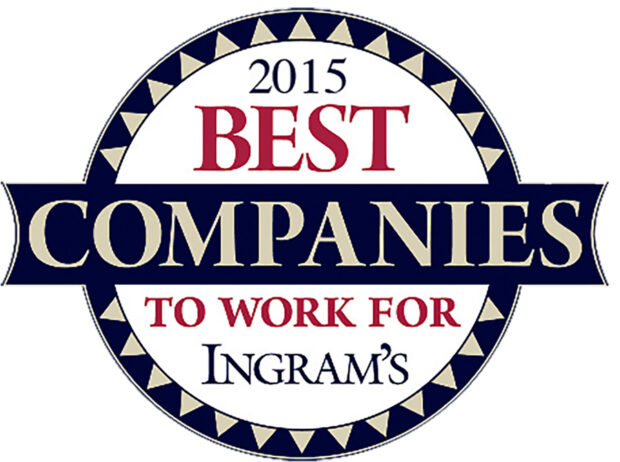
Eight years into the process of identifying the Best Companies to Work For, we’ve found the common threads to employment nirvana: Leadership with vision. Employees energized, motivated and liberated to act on that vision. Clear goals—specific, measurable and realistic.
All of that has been true with each of more than 100 companies recognized since the first installment in this feature in 2008. A cynic will look at that number and ask: How can more than 100 employers all be considered Best Companies to Work For? Well, do the math: The Kansas City region has more than 75,000 functioning businesses. So only about one company in 750 has reached that rarefied stratus in our publication, and we clearly have some hidden gems to identify.
There’s more to the winners, though, than just good pay, good benefits and good results. They almost uniformly embrace the belief that high performance is grounded in a balance that is difficult to achieve—that between the work you do inside the building, and the life you lead outside it.
That’s where innovative approaches to compensation and scheduling, where benefit packages that aren’t one-size fits all, where the little extras (Beer after hours? Chair massages?) can make all a difference between a great place to work and the very Best Companies to Work For.
So our hats go off to this year’s winners, and the employers who came before them. You’ve shown what it takes to be among the Best Companies to Work For, and by raising the bar for everyone else who issues a W2, you’ve helped make the Kansas City region all the better for it.
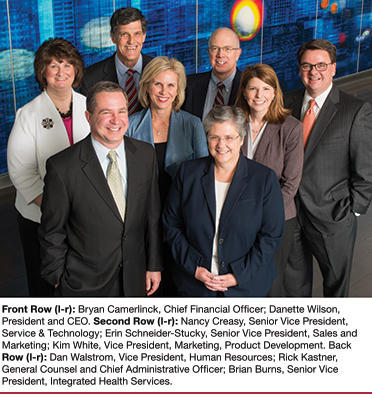
Promoting the well-being of nearly a million customers starts with taking care of more than 900 employees at Blue Cross and Blue Shield of Kansas City, the region’s largest, and only non-profit, private health insurer. And it’s a never-ending process: Officials say Blue KC is continually exploring ways to enhance its culture and environment for potential and current employees. It all starts with a wage and benefit package designed to attract and retain the talent needed to achieve company goals. But atop that base, Blue KC has built a robust benefit structure.
Consider: From their first day on the job, new employees are eligible for insurance coverage—medical, with spouse or domestic partner and children included, plus dental and vision. There are Flexible Spending Accounts, and a Health Savings Account with a $1,000 annual contribution from the company. There are both 401(k) and Roth 401(k) options, with a 10 percent company match. Employees also have life, disability (long-term and short) and long-term care insurance, tuition reimbursement, prepaid legal plans, subsidized bus passes, and free on-site parking—always a plus with a Downtown company. The work environment allows for work-from-home options when appropriate, plus flexible hours. In addition to a fully equipped, 24/7 fitness center on site, there are group exercise classes, activity challenges that include cooking demonstrations, on-site farmer’s markets and sponsored walks and runs. New since Blue KC’s last appearance among our Best Companies to Work For in 2012 is the Live Blue Kitchen + Café, offering healthy and natural foods from local and regional farmers. And there’s a corporate chef, Kyle Williams, who sets the menu.
Employees have annual performance reviews, and there are formal development plans that help maximize career opportunities for top talent. Every quarter, all employees are part of discussions on performance and new initiatives, and each is eligible for professional development courses, online training, and tuition reimbursement.
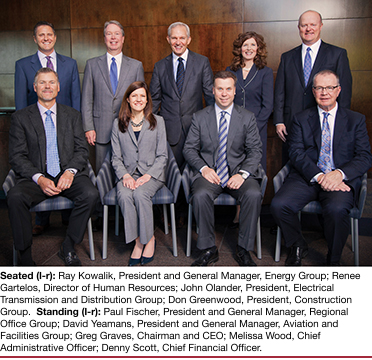
All that stuff about corporate culture? Time to rethink it. Just ask Greg Graves, the CEO who’s overseen a 67 percent increase in staffing at Burns & McDonnell since the engineering firm was last recognized as a Best Company to Work For in 2012. “Will all this growth change the culture of the company? Of course it will,” he says. “It has changed multiple times since I came to Burns and Mac in 1980. A CEO or company in general that’s in protection mode of its culture is doomed to fail.”
For the record, the cultural shift with this global engineering, architectural, construction and environmental firm shows no hint of failure. As the employee count soared past 5,000, corporate revenues have exploded, up almost exactly 100 percent from the 2011 yardstick. Burns & McDonnell is 100 percent employee-owned, which fosters entrepreneurial thinking, generosity, loyalty, hard work and fun. No surprise, then, that No. 2 on the list of six key leadership guidelines Graves keeps at his desk reads: “Employee-owned to the death.”
One slice of that culture is work-life balance: A flextime program introduced earlier this year is one; another is the core business hours of 9 a.m. to 4 p.m., Monday through Friday. In addition to a deep pool of training resources to enhance productivity, the company offers a robust line-up of services with the same goal: On-site amenities include dry cleaning, health center and workout facility, farmers’ markets and cafeteria, car wash and detailing services, massage appointments, a credit union and ATMs, and many other perks. For working parents, this one is huge: Next year, an on-site child care center will open in the new, expanded world headquarters, run by licensed child-care professionals, with space for 144 children ages 6 weeks to 5 years old.
Of course, those all add on to competitive salary structures, year-end performance-based incentives, insurance programs (medical, dental, vision, disability, life insurance and more), ample paid time off (up to 26 days, including a floating holiday), bereavement leave and, for long-term financial security, 401(k) matching and participation in the employee stock ownership plan, where participation is automatic and free.
“My objective is to make sure that the next culture that evolves at Burns and Mac is just as good as this one,” says Graves. “It will evolve whether you want it to or not, so we have to accept that and look for the next great culture you can create.”
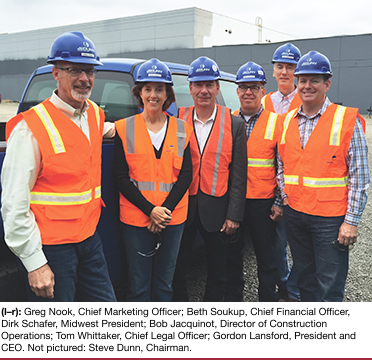
“Hire the best people you can get, give them interesting and challenging work, and let them share whatever rewards there are in the company.”
— John Ernest “Ernie” Dunn Sr., founder of JE Dunn Construction
Ernie Dunn’s framework for success is as structurally sound today as it was the day he poured the foundation for a family business in 1924. Perhaps even more so today, when you laser in on the word “share”—most of the company’s 2,795 employees own a piece of it, thanks to the switch to an Employee Stock Ownership Plan in 2011. Granted, 2010 may be a flawed base year for comparison, given the downturn then gripping America’s construction sector. But employee ownership helped maximize opportunities that arose with the ensuing rebound. And Dunn’s billings surged from $1.92 billion five years ago to $2.63 billion in 2014—an increase of 36.98 percent.
Directly sharing the company’s success inspires a culture of engagement, enthusiasm, and commitment to producing exceptional work, officials say. Beyond employee ownership itself—92 percent of employees have a stake—JE Dunn offers some impressive benefits as one of the nation’s largest contractors. The ESOP, of course, amplifies the personal wealth-creation opportunities that come with a 401(k) plan featuring a 3 percent company match. Competitive salaries and annual bonuses round out the financial aspects of the package. In addition, there are personal and professional-fulfillment initiatives that flow from ongoing training opportunities and tuition reimbursement, producing new cohorts with skills in leadership, project management, IT and business acumen. Officers complete a two-year training program to learn all aspects of construction, and many certification programs are fully funded by the company. At the LEED Gold-certified Downtown headquarters, each workspace, by design, is no more than 22½ feet from natural light. Free, healthy lunches are on the menu in the Dunn Café, and an in-house fitness facility can even accommodate work meetings with participants on treadmills
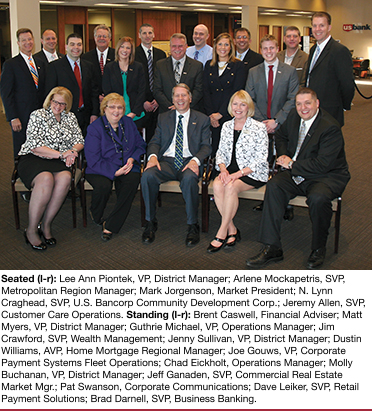
Its Kansas City operations alone would make U.S. Bank a big company, with 1,800 employees in this region. But that local cohort is part of a far larger team made up of more than 65,000 other employees nationwide. That’s a level of corporate muscle—and resources—that few employers here can match.
But for this Fortune 500 company headquartered in Minneapolis, it’s not a matter of simply being big, it’s what you do with that heft. And in three key metrics within the banking industry, parent U.S. Bancorp leads its peer group: return on average assets, return on average common equity and efficiency ratio. In other words, the foundation is rock solid. What’s being done with that? For starters, the bank has become a far larger market force here, and not just because it now has a market-leading 58 locations in the KC area.
The bank has tripled its local work force since 2008, pouring more than $250 million in the area in support of growth initiatives that include a contact center in Overland Park and high-tech data center in Olathe. And executives haven’t been shy about engaging in civic life here—none more so than market President Mark Jorgenson, whose long list of extracurriculars includes recent chairmanship of the Urban Neighborhoods Initiative that’s part of the Chamber’s Big 5 ideas for improving the regional quality of life. It extends that engagement by providing employees with up to 16 hours per year of paid time off to spend volunteering in their community, and last year, that came to more than 6,600 hours—better than three FTEs’ worth of time—in support of Junior Achievement of Middle America, Habitat for Humanity and many others. On the operations side, it provided nearly $50 million in community development loans, tax-credit investments, grants and corporate contributions, supporting the United Way, the Negro Leagues Baseball Museum and other civic pillars.
Employees there have found a sweet spot in the world of retirement benefit programs: U.S. Bank is one of the few companies around to offer both a 401(k) plan with company match of up to 4 percent of salary and a company pension (remember those?). For a 45-year-old employee with 20 years of service, that yields a pay credit of 8 percent, plus additional credit potential. The company covers 70 percent of health-insurance costs, nearly half of dental insurance premiums, and pays in full for life and long-term disability coverage.
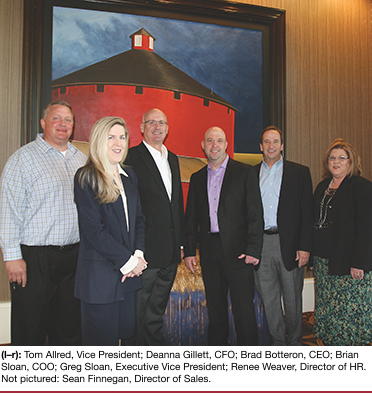
Straightforward. That’s not a management self-description we hear from many companies vying for these honors, but it’s the Wachter approach: The company wants, allows and encourages employees to advance up the ranks. It’s one way to safeguard a carefully crafted corporate culture, while also producing new cohorts of leaders that understand and embrace it. So from new hires through senior project managers, there’s training in internal trade, safety and professional development.
Based in Lenexa, Wachter is a national company providing service and solutions for electrical, data, communications, automation, and other complex building systems. Success with staff development starts with what the leadership under CEO Brad Botteron believes is one of the best salary and benefit packages in the industry: Fully paid medical, dental, vision, life and disability plans, a robust 401(k) plan that provides for immediate vesting and a 4 percent company match for employees who contribute 5 percent of their salary), employee-assistance program and paid time for job-specific training. With its holiday and vacation benefits, Wachter encourages employees to take time off for family and fun as it brings them back fully refreshed in both body and mind.
The work environment at Wachter is based on teamwork and a strong work ethic among the 1,186 employees, many of whom work in the Kansas City area. This work ethic allows employees to speak directly to the upper management, to input their ideas and suggestions. From field employees all the way up, Wachter asks its employees to always conduct themselves professionally, ethically and put forth best work practices. With the various departments and teams within those departments, Wachter embodies the “let’s get it done together” attitude where everyone succeeds and enjoys the fruits of their labor.
The company is in the process of expanding its Arkansas facility for the second time in four years and opening a new office in the Houston area this year due to the growth.
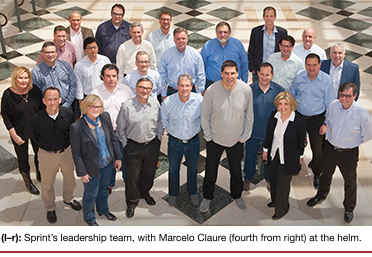
Take a look at the management team photo to the left of this sentence. You might note that one figure towers above the others, and that would be Sprint’s CEO, Marcelo Claure. But look at the wardrobes. See any ties? One implicit statement in that is, “we’re more concerned with performance than sartorial displays.” While it’s true that considerably fewer people work at the telecommunications giant than did so a decade ago, Sprint still employs roughly 6,300 in this region (36,000 nationwide) and remains one of the key private-sector employers here. And those engaged in the fight to restore profitability and shareholder value do so with a powerful set of compensation, benefit and workplace tools.
Those programs form a holistic approach to employee welfare, perhaps one of the most sophisticated strategies you’ll find among an employer in this region. Lots of great employers are great because they focus on helping employees maximize the return on the investment with their service to the company. Sprint directly states that its goal is to help employees and their families protect their health, finances and future—in other words, everything they’re about. It does so by recognizing, first, that a paycheck is just one outward sign among a range of well-being measures that include career, social, financial, physical and community well-being, then by designing benefits that address each aspect.
It starts with some of the most attractive salary packages in the market. Add to those a 401(k) plan with a generous 80 percent company match on the first 5 percent of employee salary contributions, an employee stock-purchase plan with an immediate 5 percent discount, and a hugely generous paid-time off structure that starts with 17 days for employees in their first 24 months of service, up to 30 days for 20-year veterans.
Next, there’s a rich tapestry of medical, dental, vision and life/accident insurance coverage, including a two-tiered health plan for those who earn the Healthy Living Discount (the lowest-paid employees’ $10 premium per paycheck for single health coverage is less than a third of that charged to those without the discount). There is a health reimbursement account fully funded by the company, and a flexible spending account for dependent care, there’s fully paid legal-service insurance and there’s long-term disability coverage. And when you work at Sprint, you are not working in a silo—you’re part of one of this region’s most robust displays of corporate citizenship.
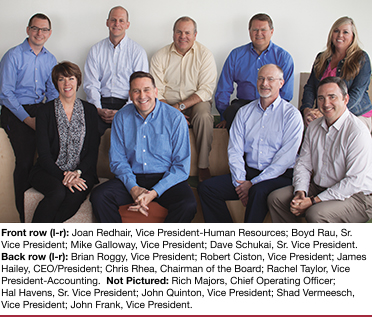
The challenge, for Merriam-based BRR: More than 175 employees work in offices across the country, and in a huge variety of design disciplines—for restaurants, grocery stores, hotels, banks and more, in new construction, adaptive reuse, sustainable design and other specialties. Getting that work force aligned to the mission starts with accessibility and openness, the leadership says, including bimonthly company meetings that include a business overview, celebrations of employee successes, previews of upcoming social and community caring events, and a progress report on company goals.
Training is both formal and through a natural mentoring that draws on the rich career experiences of the firm’s leadership: Most of the principals have been at BRR for at least 15 years, so they can provide key guidance to new cohorts of leaders, as well as encourage creativity and new points of view from them.
All employees are part of a four-session course that runs throughout the year to provide additional education on best practices for managing projects and workload, and effective team collaboration. The firm also offers study materials and organized study sessions, financial support and flexible work scheduling to encourage that learning.
The pay scale is pegged to industry standards for both professional and non-professional staff, and the benefits include paid time off for vacation and other personal matters, flexible work scheduling, a 401(k) and profit-sharing plan, with a company match plan, access to financial/budgeting education and quarterly updates from Two West Capital Advisors. Medical, dental and vision insurance are available in varying degrees that allow employees to design plans that best fit their individual needs, and there is free access for all employees to Teladoc, a program that offers anytime access to medical consultants, by phone, video or online. Life and disability insurance is fully paid, and there’s an employee-assistance program, a fitness-facility reimbursement program, membership to Sam’s Club, and eight hours of paid time annually for community-service efforts.
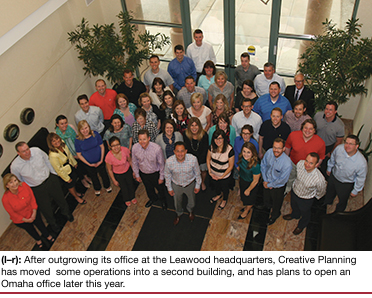
The last time Creative Planning made Best Companies to Work For, it was in the small-company category. We don’t toss around terms like “explosive growth” casually, but things are blowing up at the wealth-management firm’s Leawood offices. The firm, founded in 1971, has enjoyed growth rates of more than 60 percent in 2013 and 2014, and now manages more than $15 billion in client assets—up from less than $2 billion as recently as 2011. Now with 233 employees, it’s well into the mid-size category, and there’s more to come, with plans to open an Omaha office that will add a dozen more jobs this year.
CNBC has declared Creative Planning the nation’s No. 1 fee-only wealth-management firm, and President Peter Mallouk himself has won back-to-back acclaim from Barron’s as the nation’s top independent adviser. But he’ll be the first to tell you that success starts with hiring ultra-competent self-starters. A hands-off management style pushes accountability downward, and employees have responded enthusiastically in an environment where promotion from within is the preferred approach. With every specialist group expanding, the firm says, opportunities abound. Education and communication are key tools: Creative Planning covers $5,000 towards employees’ obtaining designation as certified financial planners, and their efforts are supported with monthly firm-wide conference calls, regular meetings between each adviser and his or her own team, an annual meeting that brings all national employees to Kansas City, and an annual firm-wide holiday gathering.
Advisers are paid based on client satisfaction measured by retention; Creative Planning attracts top talent looking to work with a firm that doesn’t have its own products/funds to sell, but is based solely on each client’s best interests. On the benefits side, there’s fully-paid health/dental insurance, a 401(k) with a 4 percent company match, employee savings plans, flexible spending accounts and HSA coming this summer. Bonus trips, usually out of the country, are awarded when business goals are met and—get this—include every person in the firm. In the quest for the ideal work-life balance, Creative Planning offers flexible hours, discretionary vacation and unlimited vacation for some positions. On Fridays in the summer, there are barbecues and firm-wide lunches, and the staff is drawn together with chili contests, charity fund-raisers and other events.
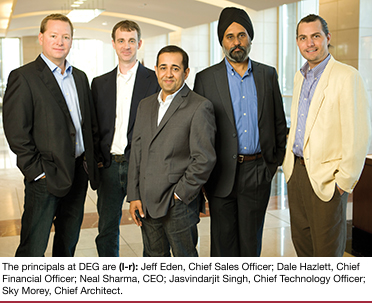
At DEG, the digital marketing and e-commerce agency in Overland Park, Neal Sharma and his four co-founding principals have worked since 1999 to ensure that the company—no matter how many it would eventually employ—would remain greater than the sum of its parts. There is, officials say, no corporate ladder at DEG—it’s a corporate lattice. Employees (now nearly 170 of them) can advance upward, of course, but they can also move laterally and into completely new areas that fit their interests. They also are encouraged to take the initiative in solving problems—to innovate, to collaborate, and to effect significant change. In other words, to be entrepreneurs in their own right. That means embracing a best-idea-wins philosophy, meaning any associate, at any level, can suggest new tactics, technologies, and business products or services that can aid clients and produce their best work. And it’s not unheard of that the person with the best winning idea is also given the responsibility for getting that new product or service line up and running.
A foundation built on seizing opportunities starts with helping employees develop the skills—technical and soft—to succeed. DEG backs that up by supporting attendance at conferences, workshops, webinars, and other skill-development sessions, and encourages sharing of that information and knowledge, turning the trainees into teachers for others on the staff. That philosophy is twinned with competitive salaries and—nice touch—a 100 percent company pay for individual medical insurance. There’s a 401(k) program, and employees have access to flex spending accounts, discounted gym memberships and corporate wellness programs. Five-year employees earn a pair of round-trip plane tickets to anywhere in the continental United States as a thank you for service. And at the 10-year mark, they can pick a destination anywhere in the world. A casual dress code bespeaks a relaxed atmosphere where employees can do their best work in a team-oriented, collaborative setting. Free juice, soda, and Starbucks coffee are on hand, and there’s “Beer:30” every Friday. Footing the bill for all this was another year of double-digit growth in 2014, one reason why the company was able to boost its work force by nearly half in that span.
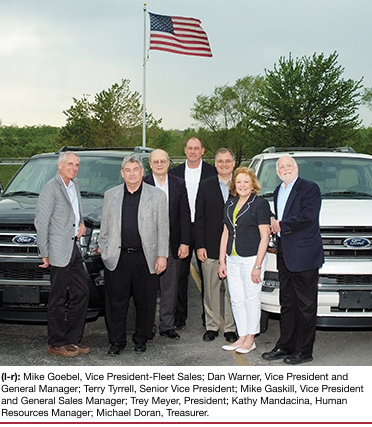
Ahhhh, employee ownership. Not exactly a gift that keeps on giving, but definitely a dynamic that keeps on motivating. Few places better demonstrate the growth-enhancing power of an employee stock-ownership plan than Midway Ford Truck Group, where revenues are up by more than a third in just the past two years, surging to a record $427.5 million in 2014. A lot of companies talking records might just stop right there. But Midway Ford proudly declares that beyond revenues, it set records for total sales, total payroll, total company-wide bonuses, shared profitability via record dividends, and retirement-account growth.
So yes, ownership matters. Founded in 1961, the company was an early adopter of the ESOP strategy, going that route in 1982—Ford Motor Co.’s first dealership with that structure. And from Day One, it was 100 percent funded by the company: No employee contributions are required to participate, and today, 44 percent of Midway Ford is owned by participants among its work force of nearly 250, and the balance by 19 current managers. Those employee owners are also empowered to make decisions to improve customer satisfaction, another metric that hit record levels last year.
Where, then, does this motivation come from? Beyond the obvious benefits of ownership, there’s a 401(k) retirement program, various health-insurance options, supplemental insurance offerings covering life,
accidental death/dismemberment, short- and long-term disability, and an employee-assistance program. There’s a bonus for employee referrals, an annual health fair and ample time-off policies covering vacation, holidays and sick days.
Promotion from within is the operating standard, in order to ensure continuity of what’s called “The Midway Way,” and there are training and education options to help employees develop the skills needed to seize career opportunities that arise. New hires in the technician reimbursement program are eligible for tuition offsets, and there are plenty of opportunities for acquiring new skills over the course of a career. “From the first day of a new employee’s orientation to the day of his or her retirement party, our employees know they can obtain support and guidance from management and all the training opportunities their jobs require,” says Kathy Mandacina, the company’s HR manager.
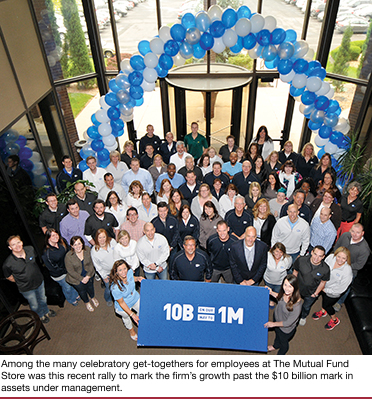
When picking Best Companies to Work For, we’ll be honest: The Mutual Fund Store had us with its vacation policy; the other arguments in its favor were just gravy: For employees who notch four years of service, The Mutual Fund Store allocates six weeks of vacation per year. And nine full holidays. And four early closure days. That’s almost up there with the companies touting unlimited vacation, but let’s be real here. You can’t get too liberal with vacation without seeing the productivity curve bend the wrong way, can you? Well, for the Overland Park-based Mutual Fund Store, with 327 employees in 120 offices nationwide, productivity doesn’t seem to have suffered at the six-week threshold: Assets under management, a key metric for wealth-advisory services, have surged past $10 billion, up nearly fourfold since 2011, and the client base stands at 37,000, up 20 percent in that time frame. So clearly, employees are getting it done.
Much of that performance, the company says, can be traced to CEO John Bunch, who succeeded founder Adam Bold in 2012. It’s not uncommon to see him mingling at a Friday happy hour with employees, hosting a company-wide pool party at his home or checking in to see how someone’s kid did in the football game last night. The workplace environment is grounded in collaboration, with quarterly town-hall mettings led by Bunch or COO Ted Bloomberg, and employees are encouraged to ask questions about the business or offer suggestions on what management can do to make it an even better place to work.
The compensation package includes annual performance-based bonuses, 401(k) plan, with the company matching up to 3 percent of annual salary for qualifying contributions, discounted advisory services for friends and family, free access to TeleDoc, for non-emergency medical issues, and six weeks of maternity leave with 100 percent pay. A casual dress code allows for employees to wear jeans year-round—and even shorts and flip-flops during the summer. Visiting food trucks provide free lunches, and summertime Fridays come with an early-out. You’ll also find workplace happy hours, quarterly Pinterest food competitions, and a holiday party employees say will rival the preparation and excitement of a senior prom.
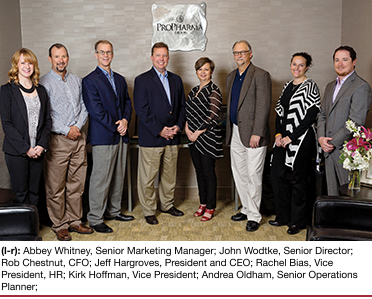
Not all turnover is created equal, so making sure your turnover involves the right people, rather than your highest performers, is a huge strategic challenge. Some studies suggest that in the health-care space, a healthy turnover rate is close to 17 percent, and if that’s true, Jeff Hargoves and his team at ProPharma Group have developed a spot-on tool kit for that challenge. Employee retention at the Overland Park compliance consulting company, which serves pharmaceutical, biotech and medical device companies, is just a hair off that, at 82 percent.
One reason for that is innovative solutions like the Road Warrior program, which helps restore the “life” part of work-life balance for employees who are nearly, or always, on the road. Those who reached their expected billable goal receive additional paid time off. Retention is also bolstered by a generous anniversary recognition program featuring bonuses and gifts, but most impressive is ProPharma’s sabbatical policy. Every five-year anniversary earns a one-month, paid sabbatical. Ten-year increments can earn handsome rewards that have included paid family vacations, Rolex watches or, for the employee who apparently had everything else, solar panels for a cabin.
In addition to competitive pay structures, there are sales incentives even for those outside the sales track, plus bonuses for employee referrals, and a 401(k) plan with a company match. There are also subsidized health, vision, and dental plans and the company pays for basic life insurance. Employees have one paid day a year to volunteer at a charity of their choice, and there’s an exercise center at the company headquarters.
Demonstrating a commitment to training, the company pays for at least one professional membership per colleague every year, often more. It also allocates up to a week of time, travel, and seminar expense per employee, and it hosts lunch-and-learn sessions year-round, open to all colleagues and topics. And in addition to the annual service day, ProPharma employees are involved in more than 15 major industry organizations, including 30 current board or committee positions.
The bottom line from all that shows up in the company’s top line: Revenue topped $46 million in 2014, up 31.4 percent over 2013, and employment more than doubled, to right at 400.
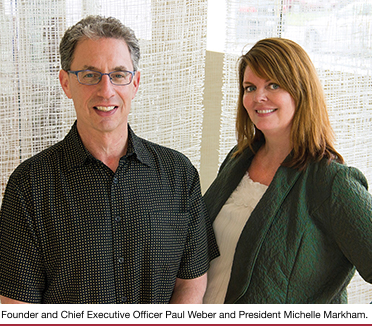
One tangible difference between EAG recognized as a winner among the Best Companies to Work For in 2010 and today’s EAG is the very cool workspace the agency has in the Freighouse District. Owner and CEO Paul Weber won’t take credit for that—“It was this way when we moved in,” he says—but he can take credit for nearly doubling the size of the team working there, now numbering 13 full-timers. But decorative glass and rapid growth do not alone best employers make. The EAG story starts with the personal lives of three employees: President Michelle Markham, account manager Dawn Kidwell and digital director Jason Keeler. All are parents with children who have varying demands on Mom or Dad’s time—and they deliver on that promise, thanks to flexible works schedules that recognize the overriding need to help employees—even the leadership—fit the non-work piece in with the work piece.
The firm’s mission statement is refreshingly uncluttered from mission-statement speak: To make big-brand advertising accessible to small companies. That simplicity and focus combines with shared entrepreneurship—nearly half the employees have completed the FastTrac program though the Kauffman Foundation, and EAG draws on the training acumen of the Women’s Business Center, UMKC’s Small Business Development Center, the Helzberg Entrepreneurial Mentoring Program and others to encourage employees to think like owners, not worker bees.
Profitable every year since its founding in 2003—we say again: every year—EAG sends a portion of the profits back to employees as bonuses, and pay scales are monitored against competitors, using two national pay models. Other benefits paid in full or in part by the firm include health, vision and dental coverage, short- and long-term disability, and a retirement savings plan, 100 percent vested after a year, with a 3 percent company match. Employees can count on the security of a diverse client base; no single client accounts for more than 10 percent of EAG’s business, and by now, the management of double-digit annual growth is in the leadership’s DNA, with more than 300 clients served to date and 25 new ones each year.
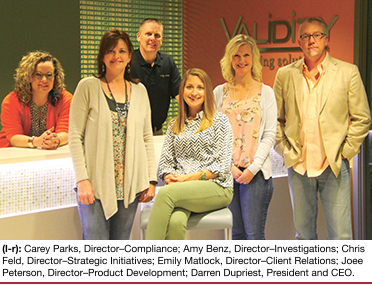
Suppose you have a company with a rare business model, but one that’s working, and you have to hire to meet rapid growth. Where are you going to find them? For Validity Screening Solutions, the answer is not from an on-line employment site: Virtually every new employee starts with exactly zero experience in the field, so this Shawnee company succeeds by growing its own talent. Each new team member is thus instructed not only in the intricacies of his or her particular job, but the overall task at hand for the company, which specializes in employment screening and testing services for other companies. Compliance education is absolutely vital for all employees, and each member of the operations team holds national certification, while all employees attend monthly continuing-ed sessions that are often built around topics suggested by employees.
Competitive pay and team-based bonuses highlight a compensation package that includes comprehensive health insurance (with the company paying 80 percent of premiums), a 401(k) program with a company match, health-savings accounts, a minimum of three weeks paid time off, plus a birthday paid holiday. And this year, part-time employees also became eligible for full-day holiday pay and incremental paid time off. “Night on the Plaza” is a recognition program for employment anniversaries, complete with hotel accommodations and $200 for shopping or dinner, and for five-year anniversaries, employees are treated to airfare for two and lodging for a three-day weekend anywhere in the U.S.
All those come in a casual and cooperative workplace environment. The routine continuing education is balanced with merrier events like in-house masseuse, ice cream sundae bar, and a staff favorite: the annual employee Lake Day, when the office is closed on a Friday and some serious recharging takes place, with families, lakeside. The last Friday of each month features “President’s Lunch,” where CEO Darren Dupriest pops for lunch and entertains any questions employees may have about the company, its operations, or its future. It is decidedly not a one-sided meal—ideas from staffers are routinely incorporated into company operations or policies. With the muscle of double-digit growth for each of the past four years, the company is able to engage in a robust series of community-service efforts. Every employee provides at least eight hours of service during paid time-off to a local, not-for-profit client, and for six straight years now, every Validity employee has volunteered at least one day.
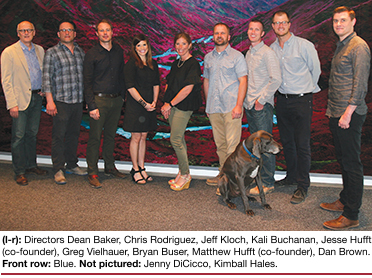
Hufft Projects is a 70-year-old—no wait: that’s the way Blue, the Weimaraner doubling as office mascot, marks time. In human terms, Hufft Projects is a 10-year-old design firm where nearly 50 employees are strewn across a wide open array of desks and fabrication settings in a 60,000-square-foot building along Karnes Boulevard’s Construction Row. The place has a distinctly upbeat vibe to it, a combination of youthful vigor, cross-functional collaboration and entrepreneurship, all under the watchful gaze of Blue, who belongs to founder Matt Hufft and his wife, Jesse Hufft. It’s a thriving company where, Jesse says, “the growth has been fast, but organic and contemplated along the way.” Design is a shared passion for the varied skill sets, and there are lots of fingers in the production pie: architects, interior designers, graphic designers, industrial designers, builders, wood and metal craftsmen, artists, building and construction managers, a marketing team and, of course, business specialists. New hires are reviewed every 90 days to make early course corrections, and annually thereafter on the hiring-date anniversary. There are weekly “touch-base” meetings, physical job boards, and Intranet software to communicate on projects. Irrespective of someone’s specialty when they start, there are ample opportunities to be exposed to, and absorb, new skills, because knowledge is always being passed down and shared.
Like a lot of young companies, it has a compensation package that’s evolving. Just last year, it rolled out a new retirement-savings plan with the SIMPLE model, by which employers can match employee contributions up to 3 percent of the annual compensation. The company covers half the cost of individual health insurance for employees, and provides optional dental, vision, long-term disability and life-insurance plans. When a fitness facility moved into the building late last year, the company negotiated a discounted rate for employees. Employees with iPhones are eligible for an 18 percent discount on their voice plans if they use a common carrier, and later this year, Hufft will complete installation of a chef’s kitchen. Blue must already be salivating over the possibility of a lunch-hour fumble.
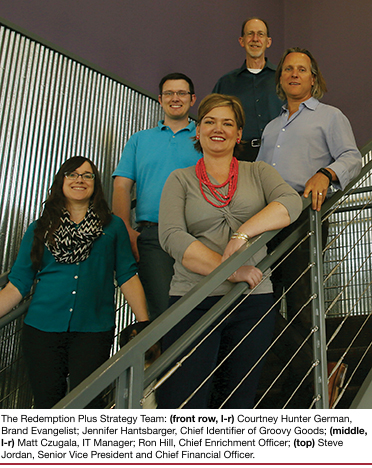
For the briefest of moments, we felt the urge to verify that Redemption Plus wasn’t sending in an application from Silicon Valley. It came when we noted that the wellness coordination program there includes toning classes, chair massages, meditation exercises, Healthy Lunch & Dinner Group, wellness challenges, and daily 5-minute exercise breaks. Oh, and an on-site exercise facility.
Nope, this originated not in some coastal capital of arugula and zinfandel, but suburban Lenexa, where Redemption Plus advertises itself as being in the business of fun. A varied product line of corporate redemption products, merchandising kits and retail display products speaks to the serious side of the company, but the fun comes shining through with the toys it distributes: balls, die-cast cars and trucks, games, crafts and electronics and a lot more.
It all starts by encouraging core behaviors—that employees are agents of change and customer-centric, as well as playful. Employees are encouraged to broaden their skills by taking on projects that kindle their passions, and a culture of collaboration has yielded a One Team, One Score mentality.
Training? It happens every day, because employees are encouraged to spend 30 minutes reading from selections in a library fully stocked with books on business, culture, marketing, self-improvement and other relevant topics. New team members are cross-trained to promote staff flexibility, and there are occasional educational retreats to learn from other companies, as with a recent tour of on-line clothing retailer Zappos.com.
Underlying that training regimen is a benefits package designed specifically to retain the best employees—success depends on it. So in addition to health-care insurance coverage, employees enjoy the benefits of a 401(k) retirement plan, disability insurance (both short- and long-term), flexible spending and dependent-care plans, plus paid time off. Flexible hours and remote working opportunities help achieve work/life balance, as do amenities like dry cleaning service, a playroom, postage allowance, full kitchen, beer fridge, and discounts on Redemption Plus products. And, in another sign of the laid-back nature of the place, you won’t be surprised at the sight of dogs in the office.
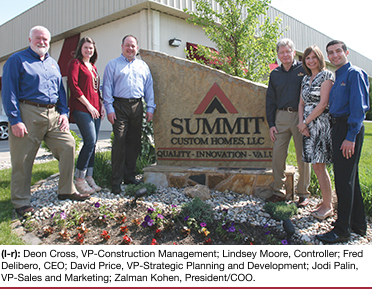
At Summit Custom Homes rigorous communication and team-building efforts are the foundation of the fast-growing homebuilder’s success. Specifically: E-mails that reach all team members with news to be shared immediately, and company-wide; notices of homes sold, so the staff can chime in with congratulations and encouragement; off-site monthly gatherings to celebarate accomplishments, and an outdoor picnic area at the office to eat and catch up with coworkers on nice days. There’s even a monthly newsletter to keep team members up to date.
Those may sound like the staff-development tools of a corporate behemoth with a bottomless in-house promotional budget, but these belong to a Lee’s Summit company with just 41 full-time employees. They must work, too: Summit Custom Homes has been one of the 100 fastest-growing companies in the region for each of the past three years, including No. 10 last year. Successful home-building requires a refined sense of changing consumer tastes, which also means understanding innovations in amenities and design. So every team member is encouraged to take part in local and national workshops and conferences, and tours of other real-estate markets help provide inspiration and ideas to implement back home.
Operationally, the company seeks to promote from within, and the benefits package includes family medical coverage with two plan options to choose from and 60 percent of the premium company-paid by Summit. The company contributes $1,250 each year to employee health-savings accounts, and a flexible-savings plan helps cover costs of child care, medications, and co-pays, all pre-tax. The company provides a 3 percent match on its 408(p) retirement plan, and all full-time employees receive medical, personal and bereavement paid time off, up to four weeks paid vacation, and nine paid holidays annually, including their birthday.
Icing on that cake: A profit-sharing program introduced this year, based on achievable profitability goals. That amenity can add from 8 percent to 15 percent to an employee’s annual salary. It’s paid quarterly in profit sharing bonuses—with no upward limit. Kinda makes you want to start swinging a hammer for a living, doesn’t it?
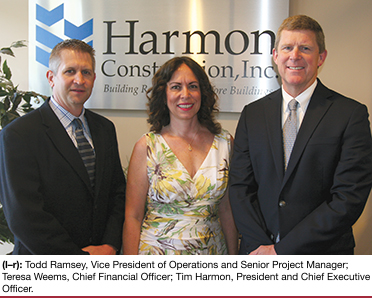
Sometimes, being among the Best Companies to Work For means the Best Company to Own. Tim Harmon found out, rather poignantly, what his core employees truly think of the company at a Christmas gathering after the big construction downturn. Harmon had pared back dramatically—including salary cuts across the company—but those employees, standing shoulder to shoulder, started singing together, then started to thank him: They were still employed.
Fast forward to the recovery: Harmon has grown from its low point of roughly a dozen people back to the pre-downturn figure closer to 30. And those employees who sacrificed to get through the lean times? They got back what they’d sacrifieced—and more—as the work returned. Two years ago, 30 percent of gross profits were distributed to associates, and that ticked up to 31 percent last year. That’s in addition to a 401(k) plan available to all employees, with a very un-small-businesslike 4 percent company match on employee contribution.
Rebuilding a staff required a benefits plan that would ably compete with larger contractors sucking up all the hiring oxygen in the region. Harmon does that with a benefits package that includes two weeks of vacation right out of the gate, plus five personal days, and six paid holidays. On top of that, the company pays 90 percent of the employee’s premiums for medical, dental and vision insurance. Harmon’s success in Olathe and beyond is also grounded, in part, by the owner’s commitment to being part of the fabric of Olathe’s business life. Tim Harmon promotes team involvement in various chambers of commerce and economic-development councils in the region, along with the time off to fill those roles. Harmon himself is a veteran of the Helzberg Entrepreneurial Mentoring Program, and applies those lessons with his own staff.
The company covers all costs for computer training, certification classes and safety training that enhance productivity, and Tim Harmon is positioning the company to help ensure that project managers are qualified to work on LEED-certified jobs. Flexible work hours are applied, as the construction schedules of clients allow, but when night work or off-hours job demand, compensatory time is made available. And, as other
contractors in the region have successfully done, Harmon is thinking long-term by implementing an employee stock-ownership plan this year, something you don’t find in a lot of companies with 30 on the payroll.